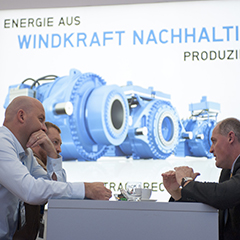HUSUM | 1 August 2017 – The timing of HUSUM Wind, in mid-September, could not be better: the dynamics of the wind energy market become apparent immediately prior to the federal election and shortly after the state elections in Schleswig-Holstein and North Rhine-Westphalia. This year HUSUM Wind will therefore be a platform for very interesting political discourse, especially since North Rhine-Westphalia is sending out a clear message as the wind trade fair’s partner state.
The elections have revealed the different political positions and issues in the energy policies of both states. Schleswig-Holstein has long been a wind energy pioneer. The newly elected state government coalition of conservatives, liberals and greens will be vigorously encouraging the wind industry. It will secure and expand wind energy as an economic factor in order to further make the most of the industry’s potential. Here the coalition will be relying on increased sector coupling and the promotion of communal wind energy projects, as well as continuing to support offshore wind projects with dedicated focus.
In contrast, the conservative-liberal coalition in North Rhine-Westphalia will rely more on fossil fuels. The planned minimum distance of 1,500 metres to residential buildings will reduce the space available for wind turbines by 80 per cent. This restricts the targeted expansion of the local wind energy market. The overall development of the local industry is considered positive. “In recent years, North Rhine-Westphalia has become the industrial heart of the wind industry. Over 90 businesses and a large communal stand from this year’s partner state are impressive proof of how tightly knit businesses in North Rhine-Westphalia are with wind energy”, says Peter Becker, managing director of Messe Husum & Congress. In addition the coalition’s plan to expand digital interconnectivity is to be welcomed. This is an aspect that will be of crucial importance to wind energy and sector coupling in the future.


























